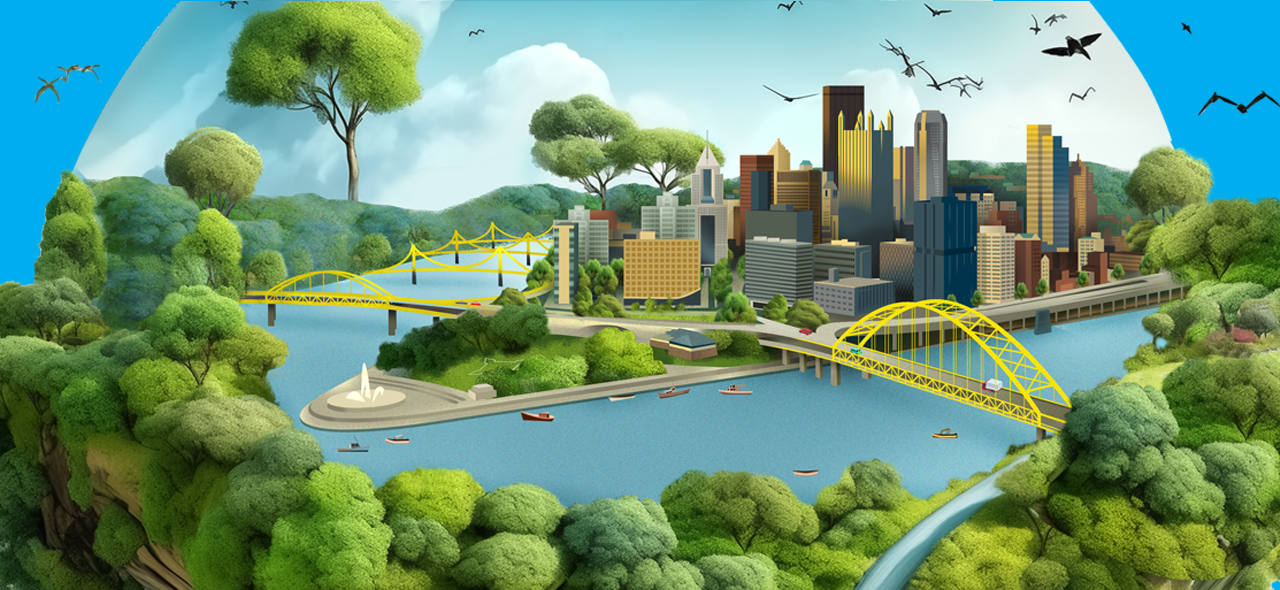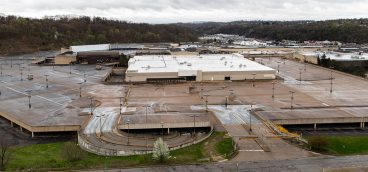Pittsburgh’s Future as a Climate Haven

If you walked the streets of Pittsburgh’s Strip District in 1924 at noon, you may have needed a lamp to cut through the thick air pollution of the city once described as “hell with the lid off.” With air twice as polluted as bad air days in modern Beijing, Pittsburgh represented the worst of the climate effects of the Industrial Revolution. British philosopher Herbert Spencer said as much in his reflection on the city’s oppressive environment: “Six months residence here would justify suicide.”
Pittsburgh in 2024 paints a different picture. Pollution has been reduced through legislative efforts, transition to less environmentally harmful energy sources, and the loss of much of the steel industry.
Now, the Steel City provides a unique allure to the climate-conscious. Naturally cooled by the Great Lakes, far from sea level rise and wildfires that threaten much of the U.S. coasts, and assured of an abundant future water supply, many have begun to look to Pittsburgh when surveying for the least bleak climate futures in America.
“As you think about what used to be the Rust Belt, it’s really the start of what will be the Water Belt,’’ said Costa Samaras, who developed and taught the country’s first climate adaptation course for engineers and is now the director of Carnegie Mellon University’s Center for Engineering and Resilience for Climate Adaptation.
Allegheny County is ranked among the top 20 American counties most resilient to climate change by the FEMA Risk Index, which ranks regions by their economic and community exposure to natural disasters, multiplied by frequency of those natural disasters occurring. This places the county as the most climate resilient in the Northeast. The FEMA Risk Index notes landslides as Pittsburgh’s No. 1 risk, and an average of seven major landslides a year.
Compare this with Chicago, which ranks as the 10th riskiest region in America by the Risk Index. Although tornadoes only hit Cook County every other year on average, it remains the No. 1 risk to the region. This is mainly due to the fact that its population and building value is four times higher than Pittsburgh’s. Pittsburgh also ranks much higher than Chicago in terms of community resilience. On average, its population is more likely to have a car, have graduated from high school and college, own a home, and speak English as a first language. These factors indicate that the region is more likely to be prepared for, withstand, and recover from natural disasters.
Finally, consider that Pittsburgh’s population has shrunk compared to its historical peak. For those seeking refuge across the nation, Pittsburgh might be seen as a place to move for a better and safer climate. “We should be thinking about ways we can welcome people who want less exposure to [climate] damages,” said Samaras. “We’ve got space, and we should make space.”
***
However, all risk is relative. According to the 2021 Pennsylvania Climate Impacts Assessment, prepared by the state Department of Environmental Protection, Pittsburgh is expected to average at least 82 days of temperatures over 90 degrees Fahrenheit by 2100, up from the five days experienced in 2023 — similar to modern-day Birmingham, Alabama. The same report projects fewer days of rainfall but more intense storms when it does rain, increasing the area’s potential for flooding and landslides.
Armed with an ambitious Climate Action Plan and hardworking researchers on climate adaptation, Pittsburgh is poised to mitigate and actively fight against these worst effects of the expected global seven-degree Fahrenheit temperature increase by 2100. When that time comes around, how will it feel to be a Pittsburgher?
“That depends on our future actions,” said Samaras.
***
On April 3, the tip of Point State Park was submerged for the first time this year. The famous triangular plot at the confluence of Pittsburgh’s three rivers is frequently used in Carnegie Mellon’s Climate Adaptation courses as an example of accidental adaptation. After four inches of rapid rain caused the Ohio River to rise over 26 feet on April 3, the Point State Park fountain, the Monongahela Wharf parking lot and the “Bathtub” section of the Parkway East filled with river water. By April 5, cleanup began around the city. The Parkway East was reopened in time for the Pirates’ home opener.
As rain levels increase over the next decade, will our current mitigation efforts be enough?
Pittsburgh’s success thus far in mitigating and combating climatic challenges has depended on the ability to predict the future. Much of this effort is driven by climate and environmental researchers who create models of the environment and climate. Marissa Webber, a CMU Ph.D. candidate with the Center for Engineering and Resilience for Climate Adaptation, has been updating and extending the primary Mid-Atlantic watershed model with the goal of predicting regional flood levels over the next 30 years.
These models are used to inform city and infrastructure planning so that new construction is built to last. CMU’s Center for Engineering and Resilience for Climate Adaptation was among the first to review and note the disconnect between the rain levels that new construction must be built to withstand and the storms that the latest climate models anticipate. In particular, the group identified more than a half-inch gap in rainfall depth between the Pittsburgh stormwater standards and the latest rainfall models. This gap addresses the dangers of planning based on mild-weathered historical data versus the latest climate change models. If not updated, future construction is less likely to be able to withstand major climate events.
Predictions get more complicated the farther out you try to predict. The more variance, the greater the probability of failure in our systems. “When we start to look 50 years or more from now, the decisions that humans are making between now and then make a huge difference,” said Webber. Data from the Fourth National Climate Assessment, led by National Oceanic and Atmospheric Administration researchers, support Webber’s claim. As the decades progress, scientific uncertainty and internal variability drop relative to the impacts of human choices. Models and sensors will get better. Current unstable systems, primarily fluctuations in the ocean state, will stabilize. However, uncertainty due to human action (or inaction) only grows as time goes on. The report states: “Most of the difference between present and future climates will be determined by choices that society makes today and over the next few decades.”
***
Pittsburgh’s Climate Action Plan was created in 2008, as part of a federal program, and updated every four years until 2018. The plan details the city’s goals by 2030, including: only renewable energy in City facilities; 50 percent reduction energy and water use in City facilities; a fossil-fuel-free City fleet; 50 percent reduction of transportation emissions citywide; and a zero-waste landfill citywide.
Progress, however, has been tepid. For example, local greenhouse gas emissions have decreased by just 0.33 percent since 2013, according to a March report — reducing the city’s goal of halving emissions by 2030 to a pipe dream. Flore Marion, the city’s assistant director for sustainability and research, said that the city will not publish further Climate Action Plans.
“Usually there’s a big disaster and something fails, and then we fix it,” Webber noted. “It takes a huge event to get humans to act.”
***
Imagine it’s Jan. 1, 2124. You vacation in Finland now in the summers to escape the heat. The outdoor ski season takes place exclusively in mountain ranges that are at least a mile high. Pittsburgh Public Schools’ last snow day was 15 years ago. Its population is now at an all-time high, thanks to migration from climate refugees — mostly former Coastal Americans whose homes were eaten up by rising sea levels.
This could be our future. What steps can we take today to promote a healthy environment, plentiful jobs, and comfortable homes tomorrow?
















